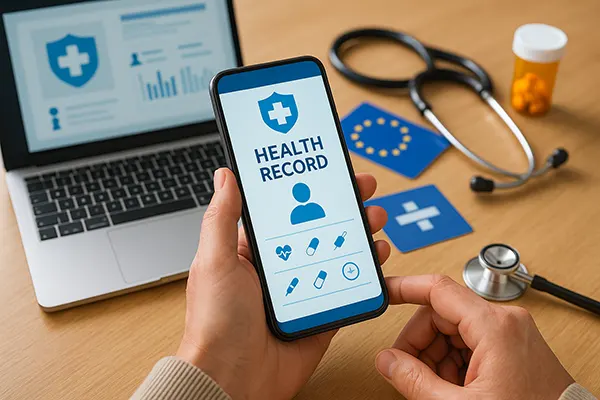Electronic health passports are transforming the way medical data is managed and shared across Europe. With the expansion of digital health ecosystems, patients, healthcare providers, and national systems are beginning to benefit from more accessible, interoperable, and secure digital health records. This evolution isn’t just about convenience — it represents a shift toward patient-centred care, increased transparency, and improved efficiency in healthcare services.
Standardisation and Interoperability Across the EU
As of June 2025, the European Union is pushing forward with the implementation of the European Health Data Space (EHDS). This initiative aims to ensure that citizens from any EU country can access their medical data in a unified, structured format, whether they are at home or abroad. Each member state is developing national electronic health record (EHR) systems in line with the EHDS standards.
The EHDS introduces a legal framework for cross-border data sharing, allowing doctors to retrieve a patient’s essential health data — such as prescriptions, vaccination records, lab results — in real-time. This interoperability is particularly crucial for emergency care during travel or temporary stays in other EU countries.
To support this, the European Commission has outlined requirements for the MyHealth@EU infrastructure — a digital backbone connecting national EHRs. As of mid-2025, countries like Finland, Estonia, and Portugal have fully integrated systems, while others such as France and Germany are accelerating pilot projects to meet compliance by 2026.
Data Security and Patient Consent
One of the most discussed aspects of digital health passports is security. Patients must be confident that their sensitive data is protected and shared only with authorised entities. Under the GDPR and the EHDS regulation, strict data encryption, multi-level authentication, and anonymisation protocols are mandated.
Equally important is patient control. The EHDS stipulates that patients must be able to view, download, and manage access to their digital health records through secure national portals. Consent mechanisms vary slightly by country but are required to be transparent and revocable.
To enhance trust, several countries have launched public awareness campaigns explaining how data is handled, who can access it, and how citizens can exercise their rights. The focus is to make the digital transition both technologically sound and socially acceptable.
Digitalisation Benefits for Healthcare Providers
Digital health records significantly reduce administrative overhead for medical professionals. Automated access to complete patient histories reduces diagnostic errors and avoids redundant testing. In countries where digital records are already in place, such as Sweden and the Netherlands, clinics report higher productivity and fewer hospital readmissions.
Doctors can now coordinate care more effectively with specialists or pharmacists through digital prescriptions and referral documents. Additionally, advanced decision-support tools can integrate with EHRs to provide real-time suggestions based on patient data and clinical guidelines.
The harmonisation also supports cross-border healthcare delivery. For example, a German resident treated in Austria can have their test results immediately visible to their GP upon returning home. This seamless care model is a key objective of the EU’s broader digital strategy for health.
Challenges in Implementation
Despite the promise, several challenges persist. Legacy systems in many healthcare institutions are incompatible with modern data standards, requiring costly overhauls. Smaller clinics, particularly in rural areas, often lack the IT infrastructure to manage digital records securely.
Healthcare professionals have also raised concerns about training and support. Successful adoption requires not only hardware but also human resources familiar with digital tools. The EU has introduced training initiatives, but local uptake varies significantly.
Another issue is the variability in national legislation. While the EHDS provides a common framework, certain countries impose stricter access rules or slower implementation schedules, which can delay full interoperability across borders.

Future Outlook and Patient Empowerment
By 2030, the European Commission envisions full deployment of digital health passports across the EU. The goal is to create a borderless healthcare experience where citizens can expect the same level of digital service anywhere in the Union. This is especially relevant for Europe’s ageing population and mobile workforce.
Personalised medicine is also gaining traction. With comprehensive digital records, AI-driven analytics can offer individual risk assessments, preventive care recommendations, and optimised treatment plans tailored to each patient’s history.
In parallel, the EHDS promotes secondary use of anonymised data for research, public health, and policy-making. This opens opportunities for more inclusive clinical trials, better pandemic response modelling, and deeper understanding of chronic disease trends.
Conclusion of a Digital Health Era
The digital transformation of healthcare in Europe is no longer a vision — it is underway. Electronic health passports are a central element of this shift, providing patients with control, improving care quality, and fostering innovation across the medical field.
As infrastructure improves and public trust increases, the widespread use of digital health data will help make healthcare more responsive, transparent, and equitable for all European citizens. The journey involves addressing technological and societal barriers, but the trajectory is set.
Ultimately, the future of healthcare in Europe is being written not in paper records but in secure, interoperable digital files — accessible when and where they are needed most.



